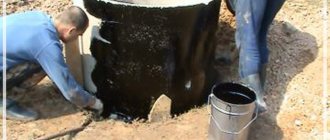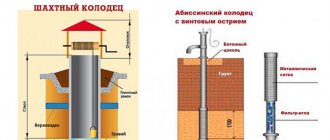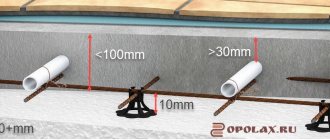Different types of wells are used in household plots, such as:
- drinking;
- shower;
- drainage;
- sewer
How are they installed? The most common method is to construct a well with concrete walls. Less common are welded structures or structures with brick walls.
All these options have one significant drawback: lack of tightness. In addition, under the influence of moisture, underground structures will collapse over time. But all this does not apply to plastic wells. They will be discussed later in the article.
Area of use
Plastic wells have many advantages. The most important thing is that they are hermetically sealed, do not enter into a chemical reaction with the environment, and slowly change their properties. Light weight adds an advantage (it can also be a disadvantage). But installing plastic rings for a well is not always easy and they cost a lot.
Shape and size are selected depending on the purpose
Polymer wells can be used for various needs - from storing drinking water to organizing drainage and sewerage. Special plastic is used and its characteristics are selected for the area of application. So, here's where you can use plastic well rings:
- Storm drainage.
- Drainage system: inspection;
- differential;
- prefabricated
Polymer sand well ring h-200mm d-1000mm
The principle of assembling a sealed plastic well.
In addition to the rings, the kit includes a bottom, a cone and a hatch. What are the advantages of using plastic for wells? First, moisture in any form does not get inside the solid body. This is true for drinking water. For wastewater collection, this is also important, as is the fact that the contents will not leak into the surrounding soil in any form. If we talk about stormwater and drainage, the important thing here is that the walls of the container are smooth and easy to clean. And one more thing - plastic does not react with either the contents or the environment.
To organize sewerage on the site, it is more convenient to use a prefabricated plastic sewer well
Another area where plastic well rings can be useful is restoration. The task is difficult and dangerous. Working in a dilapidated well, when the logs are almost rotten or the concrete rings have moved, is the height of recklessness. It is much safer and easier to restore it using an insert of food grade plastic rings. The disadvantage of this solution is the high price and reduction in useful volume. After all, the insert should be of a smaller diameter, plus they are made with stiffeners.
General information about storage tanks for sewerage
Construction of a house in a country village or on a summer cottage is accompanied by additional costs for the installation of water supply and sewerage, since there are no centralized systems in such an area. The easiest way in this case is to buy a sewer barrel or another type of storage structure where all wastewater will be discharged.
Plastic sewage containers are completely sealed and durable.
Such containers are environmentally friendly and completely sealed, but they do require regular maintenance, which includes cleaning the tank from sediment. Installing an internal sewer system in a private house is no different from installing a similar system in an apartment in a multi-story building. The only thing the owner of a suburban area will have to think about is the process of waste disposal.
Most often, the storage tank is a cylindrical tank. It is equipped with a pipe designed to collect liquid and a well, which is used for wastewater treatment. The supply pipe leading out of the house at an angle is connected to the pipe. When the tank is filled, it is cleaned through the well neck.
Note! To save money and avoid excavation work, you can install a storage structure on the surface. But in this case, the appearance of the site will be spoiled, so for aesthetic reasons it is better to hide the septic tank underground.
Sewage tanks are best installed underground.
Plastic rings for wells: materials
The raw materials for the manufacture of polymer wells can be different - from food-grade polyethylene to recyclable materials. Plastic rings for wells can be made of PVC (polyvinyl chloride), high-density polyethylene (HDPE), there are polymer sand and polypropylene (PP). For our climate, such parameters as frost resistance and the number of freezing/defrosting cycles that the material can withstand are very important. Well, the thickness of the walls, the size and number of stiffeners - all this is also important and must be taken into account.
Plastic rings for wells are made from polymers. There are options made from glass polymers - for use in heaving soils
The material from which the well rings are made is selected depending on the purpose of the well. For installing or repairing a drinking water tank, plastic ones made from food-grade polyethylene are considered the best. Moreover, the polyethylene must be primary, without foreign impurities or additives of recycled polyethylene (from recycled materials).
For difficult soils - heaving, clay, unstable - it is better to take polymer-sand plastic well rings. They are thicker (50 mm is not uncommon) and heavier. These characteristics make them suitable for use in difficult conditions.
Sizes, types and varieties
If we talk about height, plastic rings for a well can be like this:
- one-piece pipe of the required depth (insertion into ready-made reinforced concrete wells);
- a section several meters long (depending on the manufacturer), which can be extended with inserts to the desired size;
- sections of different heights (from 20 cm to 1 m) with a tongue/groove type lock and a rubber gasket;
- ring height from 20 cm to 150 cm with threaded connection.
This is just one of the manufacturers.
Others will have different sizes. It’s also worth saying that there are options with and without a bottom, adapter rings for changing the diameter, hatches with plastic covers. Plastic rings can have bends of different sizes for connecting pipes, installing pumps and other equipment. There are options for the lower tiers - with the possibility of “anchoring”. That is, the whole system is very similar to a children's construction set with a certain set of elements. From these elements you assemble the structure you need.
Here is a groove into which a rubber gasket is placed or filled with a polymer two-component sealant (silicone can also be used)
The diameter of plastic well rings is from 60 to 100 cm. But you need to look at whether it is the internal or external diameter. For better resistance to soil pressure, the walls are made with stiffeners. They can be 5 cm or even more. So with an outer diameter of 90 cm, the inner one will be 78-75 cm (depending on the wall thickness).
Reanimation of old well shafts
Using plastic wells, you can restore old water intake structures made of concrete or wood. If there is an ancient collapsed well on the site, its use will save on geological exploration.
The procedure for resuscitating an old well shaft is carried out in the following sequence of operations:
- Pump out the water and dismantle the old fittings.
- The sediment, bottom filter and part of the soil are removed.
- Geotextiles and crushed stone are used to strengthen the bottom.
- Install a well column of the required length and diameter.
- After lowering the assembled structure into the old shaft, the space between the two columns is filled with gravel and sand.
- The bottom of the well is equipped with a new bottom filter.
- It is convenient to pump water with a submersible pump lowered inside. This procedure is stopped only after clear water appears.
Plastic well on the site of an old concrete well
A well for drinking water from plastic rings: how to make
Plastic rings for a well are usually installed in a pre-dug pit. A hole is dug to the required depth, the diameter of which is 150-200 mm larger than the diameter of the rings being installed. The bottom is covered with geotextiles to prevent silting. The geotextile should extend onto the walls of the pit by at least 50 cm. A layer of crushed stone (about 20 cm) is laid on it, and the geotextile is folded over it. Crushed stone serves to filter incoming water. The following is the order of work:
- Assemble the pipe of the required length. When connecting (tenon and groove or thread), the joint is coated with polyurethane sealant. You can also use solid pipes of the desired size. They can be up to 12 meters, but if the depth is large, there will be problems with delivery.
- They lower her into the pit.
- Crushed stone is poured between the walls of the pit and the plastic. It will serve to neutralize spring heaving.
You can do it even alone - Install a bottom filter.
- Connect the outlet pipes (if any).
- Install the cover.
As you can see, the biggest difficulty is digging a hole of the required depth. If the soil is dense and stable, the technique can work, but not to any depth. Very often you have to go deeper manually. Problems also arise if the walls crumble. Then you have to install rings as you deepen. In this case, you have to dig manually - either outside or in the ring, settling the column.
Septic tank with drainage
A cesspool with drainage is the most common option for wastewater disposal in rural areas, despite sanitary and environmental standards that prohibit the use of cesspools without a concrete bottom with filtration of untreated wastewater into the ground. The use of special biological products (activators of the vital activity of microorganisms, for example, “VODOGRAY” or similar) makes it possible to extend the operating time of the pit without resorting to the services of vacuum cleaners. But if we want our estate to become truly cozy, the environment to remain clean, and the neighbors to be friendly, it is necessary to create an airtight cesspool.
Deepening an existing well
Water flow is constantly changing, and not always for the better. If there is not enough water in the well, they try to deepen it. This is easier to do with plastic rings.
You can get rid of leaks in the drinking well by installing a plastic tab
Made of concrete, log
Plastic rings can even be used to deepen a well made of concrete rings. We remove the soil only in the center so that the concrete walls do not move down. They remain at the same depth. We deepen only the middle. The size of the “middle” should be larger than the outer dimensions of the repair rings. The disadvantage of this method is that the rings need a smaller diameter. That is, again, the water reserves will be smaller, but there is no need to dig a new well.
We raise the soil to the surface until there is sufficient water flow. Next, we clean the bottom, lay a layer of geotextile, and place its edges on the walls. We pour crushed stone, level it, and place the rings of the required height assembled on the surface on this pillow. Next, we install a bottom filter at the bottom, as in a regular well.
Here's an idea
Since plastic is lighter than water, the installed repair plastic rings must be weighted. For this purpose, any load is suitable, contact with which is not dangerous for water. Ideally, stainless steel chocks and large gravel boulders. This load can be removed in 6-9 months - during this time the soil will “squeeze” the rings and they will no longer rise under any conditions.
This method of deepening a well is safer, but it is not ideal. The result is that the water will be in the plastic insert. It's a little narrower, but it's better than nothing. Everything goes much easier than when trying to add concrete rings. They must be placed on top, and if the existing ones settle, it is unclear how the entire column will behave.
How to make a plastic well deeper
If your well is made of plastic, it is usually of small diameter and working inside is difficult and inconvenient. If you need to make it deeper, the plastic sleeve is taken out of the hole. Next, you will have to clean out the crushed stone that has fallen to the bottom, which filled the gap between the walls of the pit and the sleeve. Then they remove the bottom filter and begin to remove the soil to the required depth. In the future, the actions “inside” are no different: we remove the soil until the amount of incoming water becomes sufficient.
Polymer sand rings are used for sewerage and rainwater collection
On the surface, the required number of plastic rings are added to the finished body and the whole thing is installed in the shaft on a bed of crushed stone. The next steps are already known: we make a bottom filter, pour gravel between the walls. In general, not too difficult, apart from the ground work.
The disadvantage of this method is that if the soil is loose, this trick will not work. By removing the plastic sleeve from the well, you will deprive the wall of support. This can lead to complete or partial shedding. In this case, it may be more justified to install a well.
Blitz tips
- In conditions where the septic tank is forced to be located too far from the house and the pipeline between them exceeds 20 meters in length, it is recommended to install special inspection wells at intervals of 15-20 m, especially at turns. They will allow you to monitor the condition of the pipeline and, if necessary, quickly and effectively clean the pipes without the need to dig up and dismantle them throughout the entire section.
- You can buy concrete hoops with a completely solid bottom for sale They are optimal for settling tanks and do not require additional concreting of the bottom.
- To reduce the frequency of calls to sewage disposal equipment , due to the rapid filling of the container with solid waste and to reduce their quantity, special bioactive additives can be used.
- To save money and time , it is advisable to first dig a universal pit for a sewer tank, and only then order concrete rings. This will allow you to use the unloading equipment immediately to install the rings from the machine directly into the pit.
- As concrete floors for wells , it is advisable to use slabs with hatches already built into them. This will make it possible not only to constantly monitor the process of filling the septic tank, cleaning it from sewage until it exceeds a critical level, but also to introduce into the tank solutions with special bacteria that catalyze the decomposition of waste and reduce the stench.
- For maximum effective ventilation of the structure , it is advisable to route ventilation pipes to each well separately.
Installation of plastic rings for technical wells
The process of installing a plastic sewer well or a well for any other purpose is not much different from that described. The difference can only be when installed on soils prone to heaving. In this case, there is a possibility that the container will be pushed upward. To avoid this, plastic rings for the well are secured. The most commonly used term is “anchoring”, and the process of pushing out is called “floating”.
One of the options
The traditional solution is to dig a pit a little deeper than required and make a gravel or sand-gravel cushion at the bottom. An “anchor” - a concrete slab - can be placed on this pillow. This can be a ready-made stove or a homemade one. The dimensions are larger than the bottom of the well. The slab must have hooks or “ears” to which plastic rings are attached with cables (stainless or polymer). Then the gap between the walls of the dug hole and the well is filled up. For heaving soils, it is better to use medium or coarse gravel rather than “native” soil.
Excavation
foundation pit
You will have to dig a pit large enough, since it must contain both cleaning chambers and a well for filtration. Therefore, it is advisable to entrust this work to special equipment, for example, a mini-excavator, which will significantly save time.
Manual digging of such a hole is not an easy task, and it is only rational if there are strict cost savings, the inability to rent equipment and the availability of free hands and time.
Untreated wastewater must not be allowed to seep into the ground, so it is necessary to construct a concrete base in the area where the sump is installed. A sand cushion with a layer of 40-50 cm can act as a drainage system.
The base of the filtration well also needs to be strengthened. The best option for this is a cushion of several layers of sand, gravel and crushed stone with a depth of at least 50 cm.











